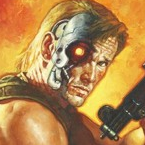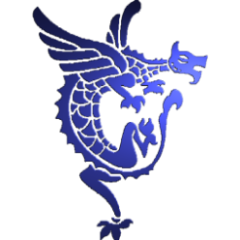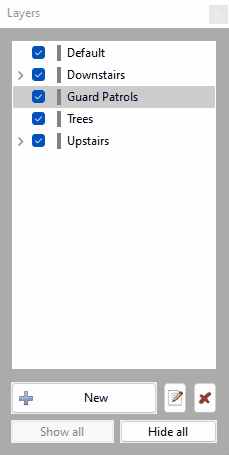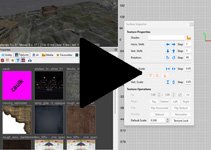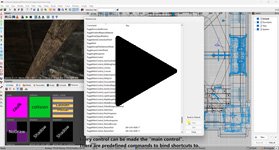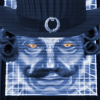Search the Community
Showing results for '/tags/forums/input/'.
-
Working on a litte expiremental deusexthemed tdm mission http://forums.thedarkmod.com/topic/18512-deus-ex-mod-like-dark-mod-is-to-thief
-
So it's been about 4 years since VR's consumer launch and with Valve finally showing 4 HL:Alyx gameplay videos today (one, two, three, and four), I figured it would be a good time to share my current thoughts about the state of VR. I like VR quite a bit myself (it's largely the only thing I play) but I also think it's an immature technology. The hardware, software, and mechanics are very early. Just anecdotally, the userbase appears to be separated into two groups: a core group of enthusiasts that are pretty regular, and a larger more casual and high turnover (low retention) group whose usage follows exponential decay. Overall it reminds me of the early phase of other major technologies/new mediums (e.g. smartphones) but with abnormal degree of hardware subsidization (abnormal for this stage of the tech) and an "improper" amount of hype. VR is also abnormal in the sense that due to the intense spectacle it typically has an extended (between a month and a year) "honeymoon phase", but this phase doesn't seem to be representative of a stable/regular user over the long term. Benefits of gen 1 VR - These are the good aspects of the current technology, but basically all of them have significant downsides as well (noted below). Immersion - This is the obvious one and what most (unfortunately) only focus on--I mean the pure spectacle of VR. It simply gives you a better sense of being "in" the virtual world and amplifies the intensity of many aspects of the experience. For example, combat intensity (Onward), horror (Walking Dead: S&S), heights and speed (Windlands 2 and Jet Island), social connection (VRChat or really anything else with multiplayer), etc etc. Each hardware iteration improves this (e.g. Vive/Rift -> Index is very nice) and playing a flat game after using VR for a while is kind of like "watching yourself" play a game in that it feels "disconnected". As an example, I have a friend that lives approximately two hours away and I would typically visit him in person several times a year. However a couple of months ago we both realized that we hadn't actually seen each other in person in almost 4 years, and yet it "felt like" we'd been seeing each other all along. I can only attribute that to the social connection afforded by VR--it's not like we weren't playing games together before that. Perceptual enhancements - Similar to immersion but with respect to things that allow one to engage with the virtual world in useful or consequential ways specific to VR. For example, a head-mapped visual perspective allowing one to look around independently, the ability to better ascertain the depth of things with stereoscopic vision, a correct perspective from which hand interactions are viable/intuitive, proper head-relative 3d audio, and so on. E.g. I find it much more rewarding and natural to communicate with nearby teammates in VR FPSs because the experience is as if they're right there in the same room as me. Interaction and new mechanics - 6 DOF inputs for both your head and hands allows one to interact with the virtual world in some interesting ways. Over time I've personally come to find that this is the most interesting aspect of VR and appreciate today's (rather limited) VR visuals more for how they provide the correct perspective for this kind of interaction rather than for the pure spectacle. A basic example of this is the well tuned firearm interaction model of Onward which can be extremely rewarding to use and changes up the dynamics of first person shooters dramatically. More complex examples would be the physics based melee combat, climbing, and general interaction models of Blade & Sorcery and Boneworks. Rather than relying on simple QTEs and a small set of mapped inputs that play out largely the same way every time they are triggered, VR opens up the possibility of accomodating an enormous number of other interaction possibilities--if the simulation allows for them anyway. Over time I've felt like flat gaming was being limited by the interface through with you engage with the virtual world and VR appears to be a way of overcoming that. Issues with gen 1 VR - It might seem odd but the attributes of VR that I find the most compelling also happen to have aspects about them that I think are the most problematic. I think the biggest issues are in the areas of comfort, "perceptual limitations", and clunky interactions. Discomforts Ergonomic Discomforts - The headsets are hot, heavy, strapped tightly to your face, and tethered. Visual Discomforts - You can't change focus so there's basically only one depth plane that is perceived correctly at about 2 meters away from the user (closer objects appear out of focus and "medium distance" objects look decent but still "off"). And there are many issues with the visuals that people are sensitive to e.g. pupil swim, distortion, god rays, glares, chromatic aberration, etc etc. Physical Discomforts - Too many games require you to stand which is ultimately a losing proposition during the critical end-of-day gaming timeslot. How many gamers are actually going to stand up to play games after work/school? Not many I think. I personally suspect that the default mode of play will eventually settle on a seated mode with smooth vertical translation on the dominant hand's vertical joystick axis, accomodated by a seat that swivels. Simulator sickness - Simulator sickness is a problem and may always be a problem. I know most can overcome it with careful exposure (and thus getting your so called "VR Legs") but getting more casual users to that point is difficult. And yet not building up one's VR legs will leave them very limited in how they can experience VR (so limited that it understandably may not even be worthwhile). I think there's a chance that this problem will always constrain VR to the more "hardcore" end of gaming (a noteable exception being for a more niche group that uses VR for "active gaming" / exercise) Perceptual limitations - Pixel density, SDE, FOV, clarity, the fixed focus, poor black levels, etc etc impose frustrating limits on how you're able to interact with the environment. E.g. devs tend to avoid near field interactions like reading something in your hand because you can't actually change focus to that depth right now. Clunky interactions In Games - In many games, the input is at least as clunky as it is compelling because current controllers are lacking in feedback, i.e. think trying to navigate through everyday life with unfeeling hands. We take for granted how complex and informative the senses of feedback through the hands are and how critical they are to even the most basic of interactions. Object reorientation, grabbing objects, throwing objects, swinging melee objects, opening doors, etc etc are all quite hindered right now. Proprioception hardly compensates and visual feedback must be largely independent of this for viable input mechanisms that aren't frustrating (imagine trying to carefully watch your hands perform even the most inconsequential interaction). Another problem is with the software itself and how well their interaction systems are being implemented. The same general interaction concepts are being implemented in a multitude of different ways, with some being rather gimmicky/pointless (i.e. you may as well just press a button to execute them) while others truly offer a degree of depth that warrants the use of motion controllers. In Desktop interaction - Outside of and in between games you really feel crippled. There's no good way (yet) for key input and we need integrated eyetracking to move past this silly laser pointer/Minority Report UI phase. Right now all of these fatigues and frustrations lead to many people not feeling particularly motivated to use the headsets very much after the honeymoon phase. Until the hardware better replicates human vision and until it is somewhat comparable to the clarity and comfort of a desktop monitor, I think VR will continue to have major retention issues. And yes, to me it's currently worth it--especially with content that does something interesting with VR beyond spectacle, but I'm just a nutty enthusiast. And, sure, when it comes to what's missing from current gen VR, "content is king" and "cost" are the reflexive platitudes you hear from most people. However, at this point VR already has a good deal of engaging content (especially given the age of the medium) and it's also about as cheap as it will get for a decent experience and for the foreseeable future (what most people don't realize is that the Facebook, WMR, and Sony headsets are subsidized), but retention remains to be an issue. The problem I see is that even an extremely polished and grand experience (like HLA) is difficult to keep coming back to month after month if what you're experiencing it through is fatiguing/uncomfortable and frustrating, especially when it's competing with the wildly successful medium of flat gaming that has been refined over many decades and that has none of VR's comfort problems. There is a very high threshold that must be overcome here (there's a big difference between "tolerable" and "I actually want to use this every evening past the honeymoon phase") and getting to that point will take some incredible technology. I don't think it will be any different for Half-Life: Alyx. Future advancements - I'm trying to be really candid about all of the issues VR has but, to be clear, I'm really interested in the technology and it's what I invest much of my free time playing and hacking around with. I could see the following things dramatically improving the experience and gradually (with each incremental improvement) making the technology something more and more PC gamers will actually use regularly. Variable focus - This is the feature that I think everyone wants without actually realizing it (though not quite the same, I think if you disabled one's ability to change focus in real life the value of this would immediately become apparent). It will dramatically improve comfort, interactivity for the near field, and immersion. Facebook detailed their approach at the last Oculus conference and others have patents for similar solutions. Unfortunately I think we'll be very lucky if we see this in the next major headset refresh around 2024 or so. General visual improvements and foveated rendering - This is with respect to things like pixel density, screen door effect, field of view, lens quality, pixel persistence, refresh rate, etc etc. Having used the Valve Index for a while, I actually think we're getting pretty close to being "good enough" here. With another decent incremental improvement beyond today's specs (for which eyetracking and foveated rendering will be required), I think the primary concerns most users have with VR technology will be focused elsewhere. Smaller, lighter and wireless headsets - The use of things like pancake lenses will allow headsets to become much smaller and lighter (there are already some examples shown at this year's CES). 60GHz 802.11ay and foveated compression will allow us to transmit the data wirelessly and with negligible latency. This should dramatically improve comfort and make the technology less distracting to the experience. The less conscious you are of the thing strapped to your head, the better. Interaction (hardware) - Haptic feedback is a major area that I really hope the industry leaders (Valve, Facebook, Sony) are focusing on internally. The single dimension of vibration in each controller is insufficient for the reasons noted above and I think the lack of feedback is the major source of motion controller clunkiness. Right now I think you need something that gives users a sense of positional and rotational forces relative to at least a single point within the motion controller (e.g. something like this https://www.roadtovr.com/miraisens-3dhaptics-directional-haptic-feedback/ ). This would give the user a vision-independent spatial sense of how their hand is interacting with the environment, how wielded objects are behaving, and how to solve "violations" of the simulation (e.g. when one's virtual hand intersects with a solid object). Like any other input/feedback system used in gaming, I don't think the feedback manifested in one's hand needs to be 1-to-1 with the simulation--the brain just needs the information in an intuitive form over a sufficient number of dimensions. However, I don't think things like full hand simulation / finger level simulation (e.g. per-finger force-feedback and touch sensation) will be viable for gaming until such an input device can adequetly simulate joysticks, triggers, and buttons itself--and something like that is so far in the future that I don't think it's even worth thinking about in the consumer space at this point. I've seen the early implementations of such a thing but I don't think they're anywhere near being viable. Interaction (software) - When the hardware interface through which one interacts with a virtual world gives the user a higher capacity for control, the software simulation must also expand in tandem to respond to that capacity (actually, not doing so can make a VR experience feel rather lifeless). Over the past few years developers have been fleshing out VR interaction systems across a wide variety of contexts to show how motion controllers can be used (with each game typically focusing on one or two core mechanics e.g. firearm simulation, flying, swimming, climbing, swinging, etc etc). More recently you see developers like SLZ (Boneworks) and WarpFrog (Blade & Sorcery) trying to generalize the interaction systems through the physics system so all aspects of the simulation behave consistently and to allow for a much larger space of potential interactions. As these mechanics improve (and there is a lot of room for improvement), I can really see VR interaction being something that is highly coveted. Anyways, I generally write things like this up just to help organize my own thoughts but hopefully it's of use to someone else. Right now I'm enjoying what VR has to offer and I'm optimistic about future tech, but I'm also a bit nervous about hardware and software developers sticking this out for another 5 years or so due to the expectations they came in with. There are only about 1.3 million VR headsets connected for the Steam Hardware Survey, and I suspect many more have been purchased but just aren't being used. I think that back in 2016 the expectations about the speed of progress were completely unrealistic. When you look at the consumer launch of other mediums and how long it takes for them to get established, 10+ years isn't that unusual. The impression I got from the VR marketing and tech journalists was that this was being treated like the launch of a new console but this was obviously something quite different.
-
I'm using the version from kcghost. I just tested and I can't see any difference inside the inventory. On the stats itself it doesn't show the different loot types (still seen in the inventory), but instead gives more info on stealth score. Edit: I see Dragofer made an updated version of his script. I have to check that out. Edit2: That version works: https://forums.thedarkmod.com/applications/core/interface/file/attachment.php?id=21272&key=02755164a3bed10498683771fe9a0453
-
Dishonoured 2: Tweaks and Fixes guide - http://forums.thedarkmod.com/topic/18494-dishonored-2-tweaks-and-settings/?p=397014
-
Also, wtf is up with the grabber? Rotating items in the grabber is bonkers stupid now. If you start rotating too quickly, or give another input, even in the same direction as the original input, it will start rotating in the opposite direction. in 2.09b it's easy for me to rotate this box back to flat. But in 2.10, I can't make any sense of what it's doing. Now, this is partly my fault, I've noticed this looooong before the beta release, but I usually don't have much reason to rotate items in the grabber, except maybe righting toppled candles, but I don't think it should be released in this state.
-
National Geographic: Mars - http://forums.thedarkmod.com/topic/18488-this-is-what-i-helped-with-today/
-
I looked but didn't see this video posted in these forums. It's pretty cool.
-

Wishlist For Darkradiant
MirceaKitsune replied to sparhawk's topic in DarkRadiant Feedback and Development
There are two things I'd like to add here please. First is the return of two features that seem to have been removed from the Surface Inspector in recent DR updates: Could you bring back the Natural button? It was used to reset a surface to its default texture mapping, in case you fit an image then changed it back to a tiling texture and want to revert to the default mapping. Now you seemingly need to select each face and manually clear any offset / rotation then set the size back to 0.25. When selecting multiple faces, most fields (Shift, Rotation, Scale) become grayed out. Old behavior allowed you to input a value which would be overridden on all selected faces. This was very useful as you could scale multiple faces at once regardless of texture. Is there a reason why this is no longer allowed? There's another little change I'd really love: When you right-click the 3D camera view to grab it and go in mouselook, can we have an option to make the WASD keys move the view? Normally those letters do other things which is fine, but while the camera is grabbed it would be great if they were overridden to act as the arrows. We're used to relying on them for walking and it's annoying to put your left hand on the arrows at the bottom-right of the keyboard to move the view. -
DarkRadiant 3.6.0 is ready for download. What's new: Feature: Selection Focus (Ctrl-F) Feature: Add Radiant.findEntityByName script method Feature: Media Browser shows a thumbnail preview when selecting folders Feature: Map is remembering layer visibilities between loads Fixed: ModelDefs are shown in T-pose Fixed: Patch vertices are the wrong colour Fixed: Shader Clipboard source gets cleared on 'copy shader' operation Fixed: Nodes of hidden layers are still visible after loading the map Fixed: Can't close properties window Fixed: Merge Action rendering is broken Fixed: After using ToggleMainControl_Camera, the center panel is grey after restart Fixed: When using ToggleMainControl_Camera, arrow keys cannot be used to move the viewer Fixed: Property Panel not remembering undocked/closed tabs Fixed: Texture Tool not updating during manipulation Fixed: Orthoview ignores filters for surfaces in models Fixed: Blue dot when selecting one face removed Tweak: Conversation Editor: double-click opens selected conversation Tweak: Preference option to disable drag select in camera view Tweak: ESC key should clear the resource tree view filter text Tweak: New layers function: tooltip popup getting in the way Feature: Selection Focus (see video) Windows and Mac Downloads are available on Github: https://github.com/codereader/DarkRadiant/releases/tag/3.6.0 and of course linked from the website https://www.darkradiant.net Thanks to all the awesome people who keep using DarkRadiant to create Fan Missions - they are the main reason for me to keep going. Please report any bugs or feature requests here in these forums, following these guidelines: Bugs (including steps for reproduction) can go directly on the tracker. When unsure about a bug/issue, feel free to ask. If you run into a crash, please record a crashdump: Crashdump Instructions Feature requests should be suggested (and possibly discussed) here in these forums before they may be added to the tracker. The list of changes can be found on the our bugtracker changelog. Have fun mapping!
- 12 replies
-
- 14
-

-

-
Announcing the Release of 'Requiem' for The Dark Mod! Download Download the latest version of the Dark Mod here: http://www.thedarkmo...wnload-the-mod/ Download the mission here: Mediafire: http://www.mediafire...u89/requiem.pk4 Southquarter: http://www.southquar...ons/requiem.pk4 Fidcal.com: http://www.fidcal.co...ons/requiem.pk4 Create a folder in your Dark Mod install with the path "darkmod/fms/requiem" and place the downloaded .pk4 file inside. When you load up The Dark Mod, the mission will appear on the "New Mission" page. Requiem can also be found directly using the in-game loader. Gameplay Notes While this mission is playable in TDM 1.8, for an optimal experience please download and play in TDM 2.0 (or higher). Most inventory items in the game can be dropped, so no need to carry them around after they are no longer of any use. Note that If you use noclip or other console commands while playing, there is a good chance that you will break the intended flow of gameplay. Credits Mapping and Readables: Gelo R. Fleisher Voice Acting: Goldwell Additional scripting: Obsttorte Additional textures and assets: Flanders, Sotha, Grayman, Springheel, Bikerdude, Obsttorte Additional map optimizations: Bikerdude Testers: Bikerdude, Obsttorte, Gnartsch, AluminumHaste, Baal, nbohr1more, PPoe Custom Soundtrack: Leonardo Badinella - http://leonardobadinella.com/ Additional Music: Lee Rosevere - http://freemusicarch...c/Lee_Rosevere/ Marianne Lihannah - http://www.funeralsinger.net/ Vox Vulgaris - http://www.last.fm/music/Vox+Vulgaris/ A note from the author Hi all. While I've been involved in indie game development for a while now, I'm first and foremost a writer. My most recent project has been a novella that tries to capture the visual feel and tone of the Thief series (you can find the link below). As I was writing, I found myself playing a lot of Thief and Dark Mod fan missions, and got to thinking that maybe I wanted to make one myself, as a companion piece to the book. When I finished up writing, I had a bit of down time and decided to take the plunge. Having never done any serious mapping before, my plan was to make a small mission that I could bang out in a month or two and call it a day. Well, as sometimes happens, the project got a little bit bigger than I had planned. Ten months, and lots of elbow grease later, Requiem is finally ready for you to play. I'd like to thank everyone who helped pitch in to help make Requiem come alive, from those who took the time to answer my many questions on the forums to those who actively contributed to the FM. I especially want to thank Bikerdude who served as my mapping mentor, and Obsttorte whose clever scripts really turned what was in my head into the game that you are playing. Above all, I want to thank you for downloading and playing Requiem; I hope you enjoy it. Links of Interest Author's Blog: http://gfleisher.blogspot.com/ Companion Novella (Amazon): http://www.amazon.co...k/dp/B00BYEW02M Companion Novella (Smashwords): http://www.smashword...oks/view/298956
- 389 replies
-
- 14
-

-
It wasn't a "sacrifice", it was a deliberate decision. People wanted the game to be as close as possible to the original, including pixelated graphics. If you ask me, the former version based on the Unity engine looked and felt better. But, hey... I guess I'm not the right person to judge that, as I never played the original, and always found that the art style of System Shock 2 is much better anyway. This also illustrates the issue with community funded games: Too many cooks spoil the broth. In game design, you need freedom, not thousands of people who want you to do this and this and that. Just take a look at the Steam forums and see how all those wimps complain again about everything. Hopeless.
-

Hidden items that become visible when illuminated by UV lamps
nbohr1more replied to MirceaKitsune's topic in The Dark Mod
Yep, you can make things that are invisible when unlit but you must use a complex material that uses the diffuse stage as an input for a transparent stage. Original discussion here: -
https://www.ttlg.com/forums/showthread.php?t=152224 There is a new mapping contest over on TTLG for the Thief: Deadly Shadows 20th Anniversary and the organizers were kind enough to include The Dark Mod along with all of the Thief games as an options for making a mission to submit as an entry. The deadline is a year from yesterday and the rules are pretty open. I recommend going to the original thread for the details but I will summarize here: Rules: - The mission(s) can be for Thief 1, Thief 2, Deadly Shadows or The Dark Mod. - Collaborations are allowed. - Contestants can use any custom resource they want, though TDM cannot use the Deadly Shadows resource pack. - Contestants can submit more than one mission. - Contestants can enter anonymously. - The mission(s) can be of any size. Using prefabs is allowed but the idea is this is a new mission and starting from an abandoned map or importing large areas from other maps is not allowed. Naturally this is on the honor system as we have no way of validating. Mission themes and contents: There is no requirement from a theme or story viewpoint, however contestants might consider that many players may expect or prefer missions to be celebratory of Thief: Deadly Shadows in this respect: castles, manors, museums, ruins inhabited by Pagans and the like, with a balance of magic versus technology. This is entirely up to the authors, though, to follow or not - it is just mentioned here as an FYI and, while individual voters may of course choose to vote higher or lower based on this on their own, it will not be a criteria used explicitly in voting or scoring. Deadline: May 25th, 2024 at 23:59 Pacific Time. See the TTLG thread for details on submissions and the voting process. Provided I can make the deadline I hope to participate. It would be nice to see the entire community do something together, and expressing our complicated relationship with this divisive game seems as good a pretext as any.
- 29 replies
-
- 15
-

-

-
Figured out how to crossfade normal maps completing Obsttortes work: http://forums.thedarkmod.com/topic/14394-apples-and-peaches-obsttortes-mapping-and-scripting-thread/page-14?do=findComment&comment=395180
-
DarkRadiant 3.4.0 is ready for download. What's new: Feature: Allow Layers to be arranged into a Tree Fixed: Readable Editor displays "shader not found" in view Fixed: Undoing snap to grid with prefabs causes crash Fixed: Include doc in building instructions Fixed: Decal textures causes DR to crash - (textures/darkmod/decals/dirt/long_drip_pattern01) Fixed: Skin chooser: double click on materials list closes window Fixed: Selecting and deselecting a filtered child brush through layers leaves the brush selected Fixed: Material editor re-sorts stages on pasting image map resulting in wrong material stages list and wrong selected stage Fixed: Crash on start if engine path is choosen (Doom 3) Feature: Layers can now be arranged to form a hierarchy Windows and Mac Downloads are available on Github: https://github.com/codereader/DarkRadiant/releases/tag/3.4.0 and of course linked from the website https://www.darkradiant.net Thanks to all the awesome people who keep using DarkRadiant to create Fan Missions - they are the main reason for me to keep going. Please report any bugs or feature requests here in these forums, following these guidelines: Bugs (including steps for reproduction) can go directly on the tracker. When unsure about a bug/issue, feel free to ask. If you run into a crash, please record a crashdump: Crashdump Instructions Feature requests should be suggested (and possibly discussed) here in these forums before they may be added to the tracker. The list of changes can be found on the our bugtracker changelog. Have fun mapping!
-
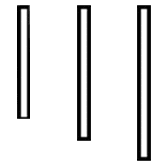
Thief: Deadly Shadows 20th Anniversary Contest
datiswous replied to Wellingtoncrab's topic in Fan Missions
What I understood is that the idea of TDM was born from that it was unclear if T3 would get a level editor at the time. Source: https://web.archive.org/web/20050218173856/http://evilavatar.com/forums/showthread.php?t=268 -
DarkRadiant 3.5.0 is ready for download. What's new: Feature: More customisable layout, all windows and panes can be dragged and arranged Layouts like Embedded, Regular and Splitpane are superseded and have been removed Tweak: The LayerControlPanel's tooltip popup is now less annoying Tweak: Clarify distinction between Shadow render mode and other render modes Fixed: Show/hide Light Volumes for combined entities inconsistent Fixed: Currently applied particleDef not selected in Particle Selector Fixed: Layer visibility checkbox not reacting to double-clicks Fixed: Cannot toggle visibility of layers in Linux Fixed: Drag-and-dropping layers is not working in Linux Feature: Customisable Layout (click to see the videos) Windows and Mac Downloads are available on Github: https://github.com/codereader/DarkRadiant/releases/tag/3.5.0 and of course linked from the website https://www.darkradiant.net Thanks to all the awesome people who keep using DarkRadiant to create Fan Missions - they are the main reason for me to keep going. Please report any bugs or feature requests here in these forums, following these guidelines: Bugs (including steps for reproduction) can go directly on the tracker. When unsure about a bug/issue, feel free to ask. If you run into a crash, please record a crashdump: Crashdump Instructions Feature requests should be suggested (and possibly discussed) here in these forums before they may be added to the tracker. The list of changes can be found on the our bugtracker changelog. Have fun mapping!
- 85 replies
-
- 16
-

-

-
Sign out of TDM forums, close browser, re-open later, "Huh...I'm still signed in?"
-
@stgatilov, you said, RE string comparisons: I'm unclear if you are referring just to changes you made in 2.11. I think equality testing of two strings (one of which is "text") was working and is a good and expected capability, and should be supported. Including against an empty string. I noticed in your bug activities that you did remove some comparisons with ... == "". I see you also removed string concatenation with "\". No problem, but does that mean multiline macros are no longer a thing? (If so, I'll need to change some examples) BTW, the series so far hasn't really tried to cover the 2.11 changes, since I figured it's a work in progress. But since you did a great deal of GUI work in July, perhaps it's stable enough to try to consider it. I see the logs listed in bugtracker, but don't have access to the private forum threads mentioned there: https://forums.thedarkmod.com/index.php?/topic/20526-gui-refactoring/&do=findComment&comment=477179 https://forums.thedarkmod.com/index.php?/topic/21535-order-of-evaluation-in-expressions-materials-and-gui/ (Nor do I have SVN currently set up on my newer machine, for changelogs from there.) Any place else I should look?
-

Thief: Deadly Shadows 20th Anniversary Contest
chakkman replied to Wellingtoncrab's topic in Fan Missions
This one is really essential: https://www.ttlg.com/forums/showthread.php?t=138607 Should work fine with the GOG version. -
working on a new project: tdmlauncher. for more info http://forums.thedarkmod.com/topic/18310-the-dark-mod-launcher/
-

DarkRadiant 3.5.0 released
thebigh replied to greebo's topic in DarkRadiant Feedback and Development
I've been having trouble getting version 3.5 to run properly on Linux. As of a few updates ago, it takes up to ten minutes to start, equally long to load even the smallest map, and then lags like crazy in the 3D view. Quitting DR takes another few minutes and then it leaves keyboard input suppressed entirely- I need to log out to be able to so much as type into a terminal again. I'm not sure what I'm doing wrong here. I'm running on Linux Mint 20.2 Uma 64-bit, MATE 1.24.0. DR isn't producing any log files or giving me any error messages that might help me figure out what's going on. -

Feedback wanted on Selection Focus
greebo replied to greebo's topic in DarkRadiant Feedback and Development
Probably not, but a couple of people around here have. I can upload it to my google drive if people don't want to create a Github account. That is something I need to look into, probably the user-defined input.xml is interfering, I have to check out how to properly override that without disrupting all the user bindings. I also thought about adding a button to the top toolbar next to the selection modes. As a workaround I can suggest pressing Alt-Tab since that will re-focus the ortho views to the selection OR the focus area if nothing is selected. So hitting Ctrl-F and then Alt-Tab should bring the ortho view into place. What about aligning the ortho view automatically to the focus once activated? Is that always desirable? I also have to make the involved colours configurable and come up with usable default colours for every colour scheme DR is shipping. I'm using the Maya/LW colour scheme since forever, and that's probably why I didn't notice it being less than helpful in Super Mal. -
Something like this. not sure if well done but works for me and was really easy, don't know why idSoftware never implemented it originally, seems very obvious and useful, only Quake 4 has similar ability. edit: Took a fast look at the wiki being done and saw this there... That is wrong and not what I recommended at all, if I passed the wrong idea then my bad, was not my intention. What I really said, is exactly the contrary, what i said is that I add problems using, in this case colors, defined with preprocessor macro #define in transitions, only when using definevec4 for that coupled with the $ sign did they work. But the better and widely used method by idSoftware was to input color values directly! Also #define macros aren't really "float parameters", like definevec4 or definefloat, they are exactly like C macro preprocessors like stgatilov said, just text substitution.
-
Not the answer I was looking for considering my lazy nature, although, I'll end up biting the bullet and doing just that. Thank you for your input


